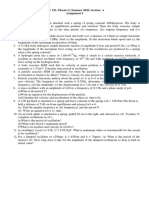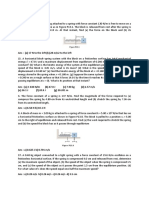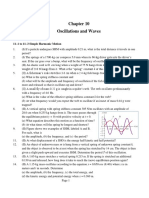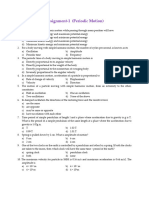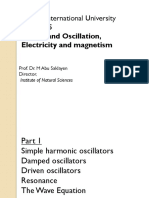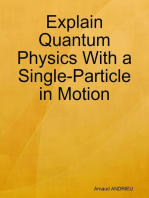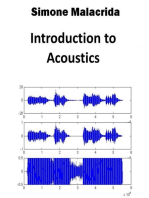0 ratings0% found this document useful (0 votes)
971 viewsPhysics I Problems PDF
Physics I Problems PDF
Uploaded by
BOSS BOSSThis document contains 21 problems about periodic motion and simple harmonic motion. It includes questions about determining amplitude, period, frequency and angular frequency from graphs or equations describing oscillatory motion. Some examples involve springs and masses oscillating with given frequencies, masses, displacements or other variables. The problems apply concepts of simple harmonic motion, such as the relationship between frequency and spring constant, to calculate unknown values.
Copyright:
© All Rights Reserved
Available Formats
Download as PDF, TXT or read online from Scribd
Physics I Problems PDF
Physics I Problems PDF
Uploaded by
BOSS BOSS0 ratings0% found this document useful (0 votes)
971 views1 pageThis document contains 21 problems about periodic motion and simple harmonic motion. It includes questions about determining amplitude, period, frequency and angular frequency from graphs or equations describing oscillatory motion. Some examples involve springs and masses oscillating with given frequencies, masses, displacements or other variables. The problems apply concepts of simple harmonic motion, such as the relationship between frequency and spring constant, to calculate unknown values.
Original Title
Physics I Problems (148).pdf
Copyright
© © All Rights Reserved
Available Formats
PDF, TXT or read online from Scribd
Share this document
Did you find this document useful?
Is this content inappropriate?
This document contains 21 problems about periodic motion and simple harmonic motion. It includes questions about determining amplitude, period, frequency and angular frequency from graphs or equations describing oscillatory motion. Some examples involve springs and masses oscillating with given frequencies, masses, displacements or other variables. The problems apply concepts of simple harmonic motion, such as the relationship between frequency and spring constant, to calculate unknown values.
Copyright:
© All Rights Reserved
Available Formats
Download as PDF, TXT or read online from Scribd
Download as pdf or txt
0 ratings0% found this document useful (0 votes)
971 views1 pagePhysics I Problems PDF
Physics I Problems PDF
Uploaded by
BOSS BOSSThis document contains 21 problems about periodic motion and simple harmonic motion. It includes questions about determining amplitude, period, frequency and angular frequency from graphs or equations describing oscillatory motion. Some examples involve springs and masses oscillating with given frequencies, masses, displacements or other variables. The problems apply concepts of simple harmonic motion, such as the relationship between frequency and spring constant, to calculate unknown values.
Copyright:
© All Rights Reserved
Available Formats
Download as PDF, TXT or read online from Scribd
Download as pdf or txt
You are on page 1of 1
464
CHAPTER 14 Periodic Motion
0.120 m on the opposite side, and it has passed the equilibrium
position once during this interval. Find (a) the amplitude; (b) the
period; (c) the frequency.
14.3 . The tip of a tuning fork goes through 440 complete vibrations in 0.500 s. Find the angular frequency and the period of the
motion.
14.4 . The displacement of an oscillating object as a function of
time is shown in Fig. E14.4. What are (a) the frequency; (b) the
amplitude; (c) the period; (d) the angular frequency of this motion?
Figure E14.4
x (cm)
10.0
5.0
10.0
15.0
t (s)
10.0
14.5 .. A machine part is undergoing SHM with a frequency of
5.00 Hz and amplitude 1.80 cm. How long does it take the part to
go from x = 0 to x = - 1.80 cm?
Section 14.2 Simple Harmonic Motion
14.6 .. In a physics lab, you attach a 0.200-kg air-track glider to
the end of an ideal spring of negligible mass and start it oscillating.
The elapsed time from when the glider rst moves through the
equilibrium point to the second time it moves through that point is
2.60 s. Find the springs force constant.
14.7 . When a body of unknown mass is attached to an ideal
spring with force constant 120 N>m, it is found to vibrate with a
frequency of 6.00 Hz. Find (a) the period of the motion; (b) the
angular frequency; (c) the mass of the body.
14.8 . When a 0.750-kg mass oscillates on an ideal spring, the frequency is 1.33 Hz. What will the frequency be if 0.220 kg are
(a) added to the original mass and (b) subtracted from the original
mass? Try to solve this problem without nding the force constant of
the spring.
14.9 .. An object is undergoing SHM with period 0.900 s and
amplitude 0.320 m. At t = 0 the object is at x = 0.320 m and is
instantaneously at rest. Calculate the time it takes the object to go
(a) from x = 0.320 m to x = 0.160 m and (b) from x = 0.160 m
to x = 0.
14.10 . A small block is attached to an ideal spring and is moving
in SHM on a horizontal, frictionless surface. When the block is at
x = 0.280 m, the acceleration of the block is -5.30 m>s2. What is
the frequency of the motion?
14.11 . A 2.00-kg, frictionless block is attached to an ideal spring
with force constant 300 N>m. At t = 0 the spring is neither
stretched nor compressed and the block is moving in the negative
direction at 12.0 m>s. Find (a) the amplitude and (b) the phase
angle. (c) Write an equation for the position as a function of time.
14.12 .. Repeat Exercise 14.11, but assume that at t = 0 the block
has velocity -4.00 m>s and displacement +0.200 m.
14.13 . The point of the needle of a sewing machine moves in
SHM along the x-axis with a frequency of 2.5 Hz. At t = 0 its
position and velocity components are +1.1 cm and -15 cm>s,
respectively. (a) Find the acceleration component of the needle at
t = 0. (b) Write equations giving the position, velocity, and acceleration components of the point as a function of time.
14.14 .. A small block is attached to an ideal spring and is moving in SHM on a horizontal, frictionless surface. When the ampli-
tude of the motion is 0.090 m, it takes the block 2.70 s to travel
from x = 0.090 m to x = - 0.090 m. If the amplitude is doubled,
to 0.180 m, how long does it take the block to travel (a) from
x = 0.180 m to x = - 0.180 m and (b) from x = 0.090 m to
x = - 0.090 m?
14.15 . BIO Weighing Astronauts. This procedure has actually
been used to weigh astronauts in space. A 42.5-kg chair is
attached to a spring and allowed to oscillate. When it is empty, the
chair takes 1.30 s to make one complete vibration. But with an
astronaut sitting in it, with her feet off the oor, the chair takes
2.54 s for one cycle. What is the mass of the astronaut?
14.16 . A 0.400-kg object undergoing SHM has ax = - 2.70 m>s2
when x = 0.300 m. What is the time for one oscillation?
14.17 . On a frictionless, horizontal air track, a glider oscillates at
the end of an ideal spring of force constant 2.50 N>cm. The graph
in Fig. E14.17 shows the acceleration of the glider as a function
of time. Find (a) the mass of the glider; (b) the maximum displacement of the glider from the equilibrium point; (c) the maximum force the spring exerts on the glider.
Figure E14.17
ax (m/s2)
12.0
6.0
O
6.0
12.0
t (s)
0.10 0.20 0.30 0.40
14.18 . A 0.500-kg mass on a spring has velocity as a function of
time given by vx 1t2 = - 13.60 cm>s2 sin314.71 s -12t - p>24.
What are (a) the period; (b) the amplitude; (c) the maximum acceleration of the mass; (d) the force constant of the spring?
14.19 . A 1.50-kg mass on a spring has displacement as a function of time given by the equation
x1t2 = 17.40 cm2 cos314.16 s -12t - 2.424
Find (a) the time for one complete vibration; (b) the force constant of the spring; (c) the maximum speed of the mass; (d) the
maximum force on the mass; (e) the position, speed, and acceleration of the mass at t = 1.00 s; (f) the force on the mass at that
time.
14.20 . BIO Weighing a Virus. In February 2004, scientists at
Purdue University used a highly sensitive technique to measure the
mass of a vaccinia virus (the kind used in smallpox vaccine). The
procedure involved measuring the frequency of oscillation of a
tiny sliver of silicon (just 30 nm long) with a laser, rst without the
virus and then after the virus had attached itself to the silicon. The
difference in mass caused a change in the frequency. We can model
such a process as a mass on a spring. (a) Show that the ratio of the
frequency with the virus attached 1S + V2 to the frequency without
S + V
1
the virus 1S2 is given by the formula
=
,
fS
21 + 1m V>m S2
where mV is the mass of the virus and mS is the mass of the silicon
sliver. Notice that it is not necessary to know or measure the force
constant of the spring. (b) In some data, the silicon sliver has a mass
of 2.10 * 10 -16 g and a frequency of 2.00 * 10 15 Hz without the
virus and 2.87 * 10 14 Hz with the virus. What is the mass of the
virus, in grams and in femtograms?
14.21 .. CALC Jerk. A guitar string vibrates at a frequency of
440 Hz. A point at its center moves in SHM with an amplitude of
You might also like
- Ac Problems 3Document4 pagesAc Problems 3Dany Emanuel Ungureanu100% (1)
- ThermolysisDocument5 pagesThermolysisJoao MinhoNo ratings yet
- Exercises August 14, 2019Document3 pagesExercises August 14, 2019Lester Patalinghug BernardinoNo ratings yet
- Home Assignment I PHY 105/PHY 2105 PhysicsDocument1 pageHome Assignment I PHY 105/PHY 2105 PhysicsMd. Imran AhmedNo ratings yet
- Physics I Problems PDFDocument1 pagePhysics I Problems PDFBOSS BOSSNo ratings yet
- Physics Practice ProblemDocument1 pagePhysics Practice ProblemnurulalomadorNo ratings yet
- Problems On The Osillatory MotionDocument4 pagesProblems On The Osillatory MotionAhmed RashadNo ratings yet
- Problems 15 Serway 6 eDocument16 pagesProblems 15 Serway 6 eAndre CVNo ratings yet
- Phy094 Tutorial 9 QDocument2 pagesPhy094 Tutorial 9 Qhafiz_yusoff1620No ratings yet
- Assignment I - PHY 101 - A PDFDocument1 pageAssignment I - PHY 101 - A PDFmkNo ratings yet
- Practice Problem Sheet 1 (SHM)Document5 pagesPractice Problem Sheet 1 (SHM)Khurshed Alam BhuiyanNo ratings yet
- Physics I Problems PDFDocument1 pagePhysics I Problems PDFBOSS BOSSNo ratings yet
- Assignment For Final Term Spring 2019-20. - 2Document2 pagesAssignment For Final Term Spring 2019-20. - 219-40122-1No ratings yet
- Physics Practice ProblemDocument2 pagesPhysics Practice ProblemnurulalomadorNo ratings yet
- Tutorial Waves and OscillationDocument3 pagesTutorial Waves and OscillationVardhan MunglaNo ratings yet
- Advanced Higher Mechanics Tutorial 6Document2 pagesAdvanced Higher Mechanics Tutorial 6veluarasuNo ratings yet
- Tutorial 10 Oscillations - 2024Document2 pagesTutorial 10 Oscillations - 2024Niza SikanyikaNo ratings yet
- I-Taalem Task - Chapter 8Document3 pagesI-Taalem Task - Chapter 8ruzaimi98No ratings yet
- Group Work 3 For S5 MPC and MPGDocument8 pagesGroup Work 3 For S5 MPC and MPGdaniel.kamanzi1343No ratings yet
- Sheet 0 Oscillatory MotionsDocument2 pagesSheet 0 Oscillatory MotionsOmer GadNo ratings yet
- TUTORIAL Ch10Document4 pagesTUTORIAL Ch10WinxTynix 8000100% (1)
- Periodic Motion 2Document4 pagesPeriodic Motion 2Tilak NeupaneNo ratings yet
- Assignment-1 Su 20 105 ADocument2 pagesAssignment-1 Su 20 105 AMd. Imran AhmedNo ratings yet
- Assignment 4Document2 pagesAssignment 4nsamkelo019No ratings yet
- SHM ReviewDocument2 pagesSHM ReviewShabbir H. KhanNo ratings yet
- Questions for TA for final exam_full (1)Document6 pagesQuestions for TA for final exam_full (1)dpkhang.170206No ratings yet
- Worksheet (Oscillation 2024)Document5 pagesWorksheet (Oscillation 2024)knorbutobgdenNo ratings yet
- TB Chapter13 PDFDocument16 pagesTB Chapter13 PDFsuryapmohantyNo ratings yet
- Repaso Bachillerato - EjerciciosDocument5 pagesRepaso Bachillerato - EjerciciosAnonymous qmwoKAfNo ratings yet
- SimmaDocument2 pagesSimmamariamasowe883No ratings yet
- Waves XiDocument4 pagesWaves XiSachin AgarwalNo ratings yet
- Physics - Assignment-1 - Fall 23 - 2105Document2 pagesPhysics - Assignment-1 - Fall 23 - 2105Zesrab Tanjeel KhanNo ratings yet
- 11 Physics Imp ch14 Marks 4Document11 pages11 Physics Imp ch14 Marks 4Parijat Deb RoyNo ratings yet
- SheetDocument3 pagesSheetAly ElbarodyNo ratings yet
- math.wave - Copy.docxDocument3 pagesmath.wave - Copy.docxAbrar AbruNo ratings yet
- Math.wave - Copy(1)Document2 pagesMath.wave - Copy(1)emonapple1234No ratings yet
- Assignment-1 Fall 20 105 ADocument1 pageAssignment-1 Fall 20 105 AMd. Imran AhmedNo ratings yet
- Tutoring QuestionsDocument7 pagesTutoring QuestionsJulieneNo ratings yet
- Practice Problem 2 (SHM)Document4 pagesPractice Problem 2 (SHM)Khurshed Alam BhuiyanNo ratings yet
- Simple Harmonic Motion Problems With Answers FINALDocument15 pagesSimple Harmonic Motion Problems With Answers FINALAngel100% (2)
- Simple Harmonic MotionDocument4 pagesSimple Harmonic MotionAli Bin SadatNo ratings yet
- Tutorial 1 SHM and OscillationDocument6 pagesTutorial 1 SHM and OscillationellyNo ratings yet
- 12 5 2018 15 32 58 119 QBank PH1103 EnggPhysicsDocument11 pages12 5 2018 15 32 58 119 QBank PH1103 EnggPhysicsRNo ratings yet
- Physics I Problems PDFDocument1 pagePhysics I Problems PDFBOSS BOSSNo ratings yet
- SHM and Waves Problem SetDocument5 pagesSHM and Waves Problem SetbananacrunchNo ratings yet
- Assignment 1Document1 pageAssignment 1extremenihanNo ratings yet
- Vibrations and Waves: Quick QuizzesDocument36 pagesVibrations and Waves: Quick QuizzessuryapmohantyNo ratings yet
- AL Physics/S.H.M./P.1: DX DT BXDocument4 pagesAL Physics/S.H.M./P.1: DX DT BXmiguelNo ratings yet
- Practice Problem Sheet 3Document2 pagesPractice Problem Sheet 3iamrabbiislamemonNo ratings yet
- Assignment 1 - Simple Harmonic MotionDocument2 pagesAssignment 1 - Simple Harmonic MotionDr. Pradeep Kumar SharmaNo ratings yet
- 1st YearDocument2 pages1st Yearfiker23swNo ratings yet
- Periodic SHM RADocument10 pagesPeriodic SHM RADetective ConanNo ratings yet
- Assignment 01 PHY 1111Document2 pagesAssignment 01 PHY 1111nubaidfahad65No ratings yet
- Hapter: Conceptual ProblemsDocument19 pagesHapter: Conceptual Problemsadel0% (1)
- Chapter 9 (Simple Harmonic Motion and Waves) : I.M. NoorDocument3 pagesChapter 9 (Simple Harmonic Motion and Waves) : I.M. NoorEhh ManNo ratings yet
- 1 Problems Oscillations PDFDocument9 pages1 Problems Oscillations PDFBryan ChachaloNo ratings yet
- Taller 1Document4 pagesTaller 1manuelNo ratings yet
- Chapter 2 - Oscillation - WavesDocument4 pagesChapter 2 - Oscillation - Waveshoangkhanhvn8No ratings yet
- United International University PHY 2105: Waves and Oscillation, Electricity and MagnetismDocument135 pagesUnited International University PHY 2105: Waves and Oscillation, Electricity and MagnetismMd. Imran AhmedNo ratings yet
- Explain Quantum Physics With a Single-Particle in Motion: Anharmonic OscillatorFrom EverandExplain Quantum Physics With a Single-Particle in Motion: Anharmonic OscillatorNo ratings yet
- CBSE Class 1 English WorksheetDocument2 pagesCBSE Class 1 English WorksheetBOSS BOSS100% (1)
- CBSE Class 1 English WorksheetsDocument1 pageCBSE Class 1 English WorksheetsBOSS BOSSNo ratings yet
- CBSE Class 1 English WorksheetDocument1 pageCBSE Class 1 English WorksheetBOSS BOSSNo ratings yet
- CBSE Class 1 English WorksheetDocument1 pageCBSE Class 1 English WorksheetBOSS BOSSNo ratings yet
- CBSE Class 1 English WorksheetsDocument1 pageCBSE Class 1 English WorksheetsBOSS BOSSNo ratings yet
- CBSE Class 1 English WorksheetDocument1 pageCBSE Class 1 English WorksheetBOSS BOSSNo ratings yet
- CBSE Class 1 English WorksheetDocument1 pageCBSE Class 1 English WorksheetBOSS BOSSNo ratings yet
- CBSE Class 1 English WorksheetsDocument1 pageCBSE Class 1 English WorksheetsBOSS BOSSNo ratings yet
- CBSE Class 1 English Worksheets (17) - After A BathDocument1 pageCBSE Class 1 English Worksheets (17) - After A BathBOSS BOSSNo ratings yet
- CBSE Class 1 English WorksheetDocument1 pageCBSE Class 1 English WorksheetBOSS BOSSNo ratings yet
- CBSE Class 1 English Worksheets (16) - A Happy ChildDocument1 pageCBSE Class 1 English Worksheets (16) - A Happy ChildBOSS BOSSNo ratings yet
- TN HSC Physics Bookback One MarksDocument1 pageTN HSC Physics Bookback One MarksBOSS BOSSNo ratings yet
- CBSE Class 1 English Worksheets (19) - Bubble, Straw and ShoeDocument2 pagesCBSE Class 1 English Worksheets (19) - Bubble, Straw and ShoeBOSS BOSSNo ratings yet
- Additional One Marks Question Paper 1Document1 pageAdditional One Marks Question Paper 1BOSS BOSSNo ratings yet
- Bpharm 4 Sem Physical Pharmaceutics 2 bp403t 2023Document1 pageBpharm 4 Sem Physical Pharmaceutics 2 bp403t 2023singhabhishek.ohm00No ratings yet
- 2020 Behi ''A New Concept of Thermal Management System in Li-Ion Battery Using Air Cooling and Heat Pipe For Electric Vehicles''Document14 pages2020 Behi ''A New Concept of Thermal Management System in Li-Ion Battery Using Air Cooling and Heat Pipe For Electric Vehicles''Abdul RehmanNo ratings yet
- Joly PhotometerDocument3 pagesJoly PhotometerAndrei ImashauNo ratings yet
- Dr. Murtuza: Academic QualificationsDocument2 pagesDr. Murtuza: Academic QualificationstalhaalamNo ratings yet
- Po Kok Sec. School Chemistry S. 3 First Semester: Date Content Grade Correction ( /×)Document37 pagesPo Kok Sec. School Chemistry S. 3 First Semester: Date Content Grade Correction ( /×)Belladonna LeeNo ratings yet
- Application of Finite Difference Method To The Elastic Analysis of Thin PlatesDocument7 pagesApplication of Finite Difference Method To The Elastic Analysis of Thin Platesjeevitha nNo ratings yet
- GeoSpec-application-note-3 - NMR-log-calibration-from-laboratory-core-measurementsDocument4 pagesGeoSpec-application-note-3 - NMR-log-calibration-from-laboratory-core-measurementsSamuel AguiarNo ratings yet
- Belzona 1321 (Ceramic S-Metal) - Product FlyerDocument2 pagesBelzona 1321 (Ceramic S-Metal) - Product Flyervangeliskyriakos8998No ratings yet
- TWI Radiographic Interpretation Part 1 Course Reference WIS 20 2004Document66 pagesTWI Radiographic Interpretation Part 1 Course Reference WIS 20 2004ehsan hatami100% (1)
- Flow Around Bluff Bodies With Corner Modifications On Cross-SectiDocument104 pagesFlow Around Bluff Bodies With Corner Modifications On Cross-SectiLuis RiosNo ratings yet
- Heat Treatment and Designation of SteelDocument3 pagesHeat Treatment and Designation of SteelJose AlfonsoNo ratings yet
- Pressure Nominal - PN: Cto60 C Considering The Change ofDocument5 pagesPressure Nominal - PN: Cto60 C Considering The Change ofCarlos KraljevicNo ratings yet
- Wide Swath Bathymetry and Side Scan Sonar Geoswath 4Document2 pagesWide Swath Bathymetry and Side Scan Sonar Geoswath 4Mihai DragomirNo ratings yet
- Machine Design - INHOUSE 3Document28 pagesMachine Design - INHOUSE 3Pia May Torres PablicoNo ratings yet
- Thermal EquiliriumDocument5 pagesThermal EquiliriumMOHAMAD RIZAL BIN MUKHTARNo ratings yet
- Guideline For Preparing IPDS - Instrument Process Data SheetDocument3 pagesGuideline For Preparing IPDS - Instrument Process Data Sheetbalaji krishnan100% (2)
- Seismic Provisions in The Saudi Building CodeDocument12 pagesSeismic Provisions in The Saudi Building CodeMILL3482No ratings yet
- Bosch - Rexroth - Diaphragm Model HAD AccumulatorDocument24 pagesBosch - Rexroth - Diaphragm Model HAD AccumulatorMichael AkhramovichNo ratings yet
- Non Destructive TestingDocument16 pagesNon Destructive TestingMadhava Padiyar100% (1)
- 2016-Edouard - Parameter Sensitivity Analysis of A Simplified Electrochemical Oand Thermal Model For Li-Ion Batteries AgingDocument13 pages2016-Edouard - Parameter Sensitivity Analysis of A Simplified Electrochemical Oand Thermal Model For Li-Ion Batteries Agingsofiane maïzaNo ratings yet
- ENPHYS30 1 Work and EnergyDocument35 pagesENPHYS30 1 Work and Energychlorine169No ratings yet
- Equivalent Weight QuestionsDocument3 pagesEquivalent Weight QuestionsMuzan NishiNo ratings yet
- Astm D2186Document7 pagesAstm D2186JesusNo ratings yet
- SSM College of Engineering and Technology: Seminar ReportDocument9 pagesSSM College of Engineering and Technology: Seminar ReportNaveed BeighNo ratings yet
- Solar Thermal Storage Using Phase Change MaterialsDocument51 pagesSolar Thermal Storage Using Phase Change MaterialsAhmed Mohamed Abd ElhakamNo ratings yet
- Liquefied Gas Pump Installation GuideDocument6 pagesLiquefied Gas Pump Installation GuideLuis Meza ArevaloNo ratings yet
- Lab 10 - ANSDocument3 pagesLab 10 - ANSRazer69No ratings yet
- Lawrence Pumps VPL1700: Multistage Vertical Toxic Liquid PumpDocument8 pagesLawrence Pumps VPL1700: Multistage Vertical Toxic Liquid PumpjnNo ratings yet
- Rate of Reaction QPDocument21 pagesRate of Reaction QPHina Saeed ChNo ratings yet









